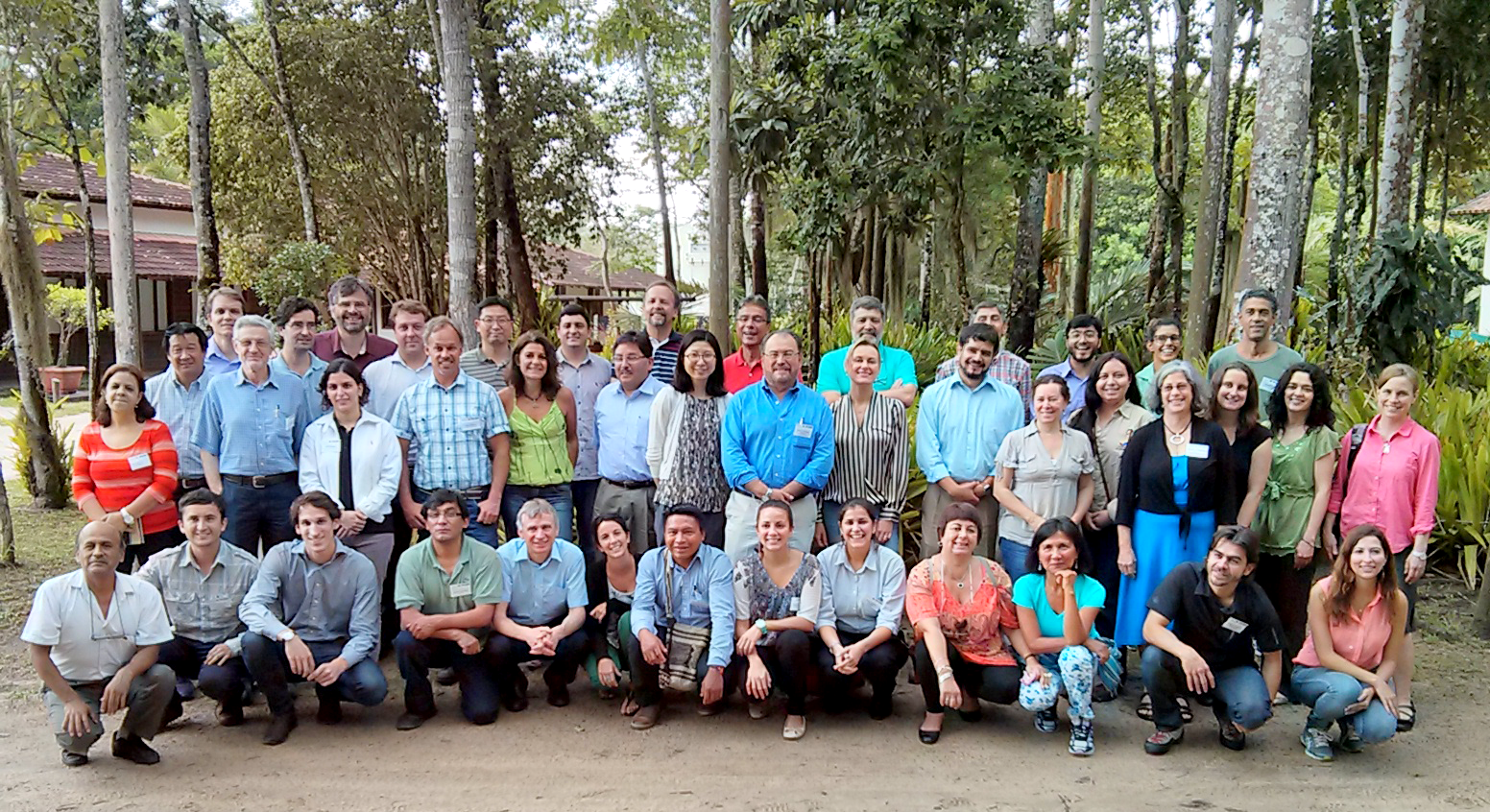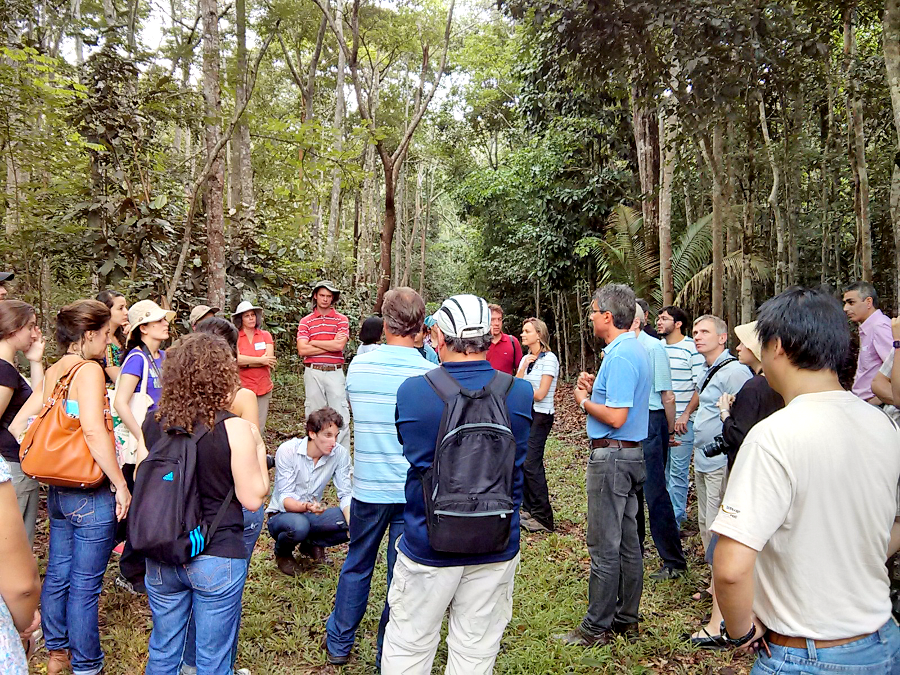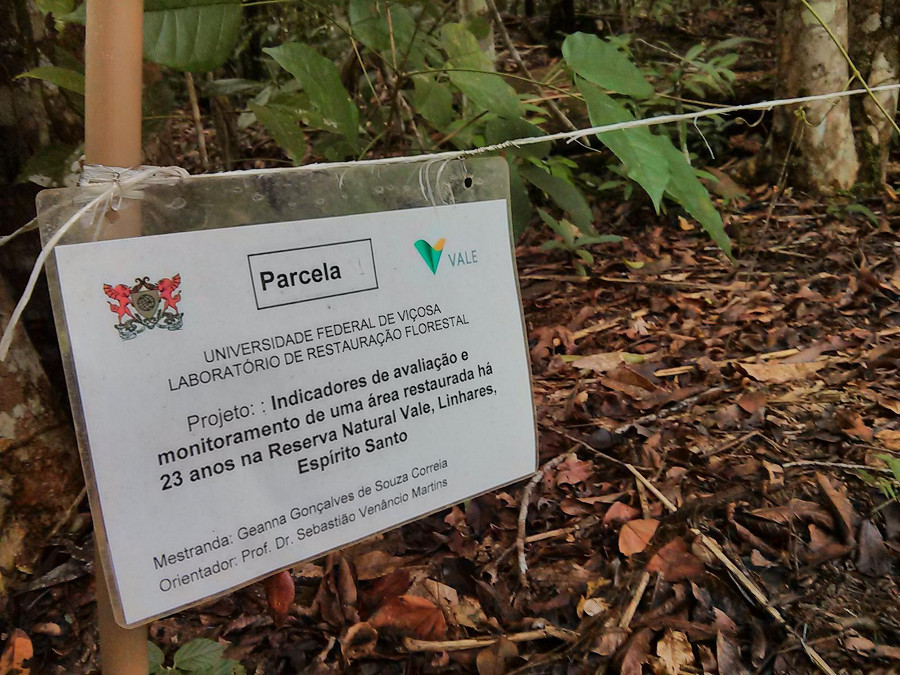

From the 24th to the 28th of March, 2014, the Convention of Biological Diversity (CBD) Secretariat organized the “Capacity-building workshop for South America on ecosystem conservation and restoration to support achievement of the Aichi Biodiversity Targets” workshop in Linhares, Brazil. During this event, CIAT-CGIAR was invited to present and discuss the latest achievements of the Terra-i initiative.

Figure 1. Group photo: diverse attendees and representatives from South American Environmental Ministries, Intergovernmental institutions, NGOs and involved stakeholders participated in the workshop.
As part of COP10 negotiations lead by the Convention of Biological Diversity, the implementation and functioning of the “Strategic Plan for Biodiversity 2011–2020” which aims to be a basic and structural instrument to protect biodiversity, were discussed. This global initiative, which integrates multiple governments and stakeholders within a common framework, is a global ten-year initiative that commits governments to protect biological diversity and strengthen the functioning of ecosystem services and the ensuing benefits to human well-being. It is a shared vision and an integrative mission, with 20 global goals (Aichi Targets) that are arranged within five strategic aims.
To quantify and facilitate the achievement of this initiative, the CBD Secretariat has organized regional capacity building workshops to discuss the latest progress in Aichi biodiversity targets for each country. Thus, from the 24-28th March, the Capacity-building workshop for South America on ecosystem conservation and restoration to support the achievement of the Aichi Biodiversity Targets took place in Linhares, Brazil. Diverse CBD parties, mainly representatives from environmental ministries and official institutions, and special guest from South Korea, and local (University of Sao Paulo) and international universities (University of Connecticut) presented their achievements and discussed their experiences with the participants. In addition, world-recognized intergovernmental institutions and NGOs such as the Food and Agriculture Organization of the United Nations (FAO), The United Nations Environment Programme (UNEP), the International Union for Conservation of Nature, the World Resources Institute (WRI), Conservation International (CI) and the International Center of Tropical Agriculture (CIAT) presented a variety of tools and applications that can be used to assist decision making in regards to regional biodiversity conservation and management.

Figure 2. This workshop provided a tour to visit multiple schemes of restoration in the Vale reserve (host place) where 80% of Brazilian Atlantic Forest of Espirito Santo State is located.
Target 5 – To ensure at least a 50% reduction in habitat loss
The large development in protection and monitoring of forest ecosystems has greatly contributed to target 5. Brazil is the country which has seen the most substantial improvements in forest protection. A combination of sophisticated monitoring systems based on satellite data with political and legal developments, such as the consolidation of fiscal control which has complemented and strengthened a pro conservation legal framework for threatened and internationally important ecosystems (such as the Amazon), has helped to drive the improvements in forest management and conservation in Brazil. In addition, deforestation monitoring initiatives at varying levels of coverage, such as those undertaken by the Global Forest Watch (GFW) and Terra-i from WRI and CIAT/CGIAR, respectively, are playing a key role in supporting the remaining nations which lack, are currently developing or desire to improve national monitoring capacity in order to reach target 5. Also, it was clear from the workshops that payments for environmental services, such as the REDD+ are important, countries such as Ecuador (Socio Bosque Program) and Colombia Indigenous Communities have implemented such projects with the aim of reducing losses to vulnerable ecosystems.
Target 11 - Expand coverages of protected and conservation areas system
Protected and conservation areas are key to sustaining biodiversity and are as important as mitigation strategies for climate change. To 2020, the aim is to increase coverage by 17% for terrestrial and maritime ecosystems; more efforts however are needed to achieve this target. Furthermore, not only more coverage has to be considered but also an improvement in the approach to management and particularly in ensuring connectivity inside the protected and conservation areas. As a consequence, such a move could provide greater benefits to flora and fauna dispersion and exchange and at the same time protect both intact and vulnerable ecosystems against anthropogenic pressures.
For this target, it should be noted, in addition to ARPA Brazilian strategy, the role of Peru and Uruguay for developing innovative methodologies for their protected areas network. In Peru, a protection scheme called "conservation mosaics" was introduced that seeks to protect not only the core areas but also through other conservation modalities to create a set of adjacent areas that protect entire surrounding areas. For the Uruguayan case, the protected area planning has been based on previous studies of all major sites with high provision of ecosystem services by basin, this ensures that areas that provide greater benefits for both human and environmental services are protected.
Target 15 - Restoration of degraded ecosystems for mitigation and adaptation to climate change
Being restoration one of the concepts most developed during the last decades, it has advanced beyond a practice of planting trees and taking today well-structured methodologies to assess their feasibility considering the national context of each nation, and also different sets of schemes whose benefits and costs of implementation can be valued economically. Similarly, nowadays there are several restoration strategies that take into account multiple inputs to get the most adequate potential zones according to cultural, economic and biophysical assessments including native plant and tree species.
It is noteworthy the role of Colombia and Brazil for this target leading in the region with concrete plans for national restoration strategy. In the case of Colombia, there is an initiative to restore dry forests and in Brazil a major focus is being given to the Atlantic Forest. Both ecosystems were in the past abundant and rich like tropical rainforests, but both are now facing major challenges for recovery.
Financial and institutional support of the proposed
Due to the rise of these issues by governments, a section of the workshop was attended by representatives of regional funding institutions such as the Development Bank of Latin America (CAF), the Brazilian Development Bank (BNDES) and the National Fund for Areas Protected (PROFONANPE). They reported increased availability of funds for projects related with Biodiversity, specifically those related to the realization of the Aichi targets. Similarly, the CBD secretary has the Life Web initiative which aims to facilitate the presentation and resource mobilization of proposals for CBD parties and partners to potential donors.

Figure 3. Research on restoration issues requires some considerable time to produce results. Therefore it is becoming increasingly important that donors also start considering any support for this purpose from educational institutions, thus complementing the support for proposals at government level and cooperating entities.
Conclusions
As a result, this workshop was an excellent opportunity for the nations of the region to share their experiences and create a contacts network to continue the exchange of outcomes. Although ecosystems, and the cultural and economic context varies among nations, note that the methodologies transfer need to be continually explored within the South America region which despite having a high natural resource wealth has been highly vulnerable to biodiversity loss due to increasing population and economic development. The future is also expected to require not only the restoration of forest ecosystems but also extension to savannas, wetlands, paramos and other ecosystems which are still very common in the landscape of the South American region.
The Terra-i initiative, CIAT and the CGIAR community in general thanks the CBD and the hosting government of the event (Brazil) for the invitation and organization of this workshop. Also, our network encourages nations and government institutions to consider CGIAR as a collaborator for ecosystem conservation and restoration national plans. Formed by a global group of research centers, the CGIAR provides constant support for decision making for the conservation and management of natural resources based on information and tools with high-level scientific and quantitative application.
Blog post by Alejandro Coca. Revision of English-language version by Louis Parker (CIAT / DAPA visiting researcher).

The Terra-i team together with CRS El Salvador under the Raices project carried out a virtual workshop through the teams platform to technicians from the Ministry of Environment and Natural Resources, CARITAS, Universidad El Salvador, CENTA, about the Mapping of land cover using remote sensors and open source tools such as GEE, SEPAL and QGIS- Plugin Semi Automatic Classification.

Near real-time vegetation loss detection in Southwestern Ethiopia: calibration, validation, and implementation of the Terra-i system

The Alliance of Bioversity International and the International Center for Tropical Agriculture (CIAT) (the Alliance) conducted a training for local stakeholders on the use of Terra-i as part of the collaboration with the Netherlands Development Organisation – SNV in the Coffee Agroforestry and Forest Enhancement for REDD+ (CAFÉ-REDD) Project.


From May 8-12, 2017, the Terra-i team, together with staff from the DGOTA of Peru's Ministry of Environment, carried out the first field validation of vegetative land cover changes detected during Terra-i monitoring for 2016 and 2017, using the technology UAV. This work was carried out under the framework of the project “Sustainable Amazonian Landscapes”. The team carried out over-flights with a Phantom 3 advanced rotor drone and a fixed-wing Ebee drone in seven townships of Yurimaguas. The objective of this work was to recognize the dynamics of land cover and land use changes in the region while at the same time to validate the accuracy of the detections of forest loss being monitored by Terra-i in Yurimaguas.

The Terra-i team has worked hard on renovating Terra-i’s website since early this year. A set of new features on the website provides interactive contents and facilitates adaptation to the mobile devices of our users. The fresh website was developed using the latest update of an open-source, Java-based web system, Magnolia CMS 5.4.4. This update was customized to add different categories of interaction such as news, vegetation cover changes, and information, among others.

Globally more than 1 billion people depend on forests for their livelihoods. Forests play a crucial role in climate regulation, ecosystem services provision and regulation, water supply, carbon storage and many other functions that support biodiversity. Currently the global rate of deforestation is substantial, and there is a growing need for timely, spatially explicit data that flag natural vegetation changes due to human activities.

The latest update of Terra-i has been used with the Co$ting Nature ecosystem services assessment tool to understand the impacts of recent forest loss in Colombia on biodiversity and ecosystem services.

During the 1st and 12th of June 2015, the Terra-i team, together with the Instituto de Investigaciones de la Amazonía Peruana (IIAP) and the Universidad Nacional Agraria La Molina (VLIR-UNALM), conducted the second field validation of the data produced by the Terra-I system. This time, the study area was the Yurimaguas district, Alto Amazonas province, Loreto region (Peru). We used information on populated places, main roads, rivers and information on land cover changes detected for 2013, 2014 and 2015 to define the 65 sampling points (or Terra-I pixels) for the validation process (Figure 1).